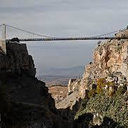Antioxidant, anticholinesterase and antibacterial activities of Stachys guyoniana and Mentha aquatica.
Schlüsselwörter
Abstrakt
BACKGROUND
Stachys guyoniana Noë ex. Batt. and Mentha aquatica L. are two Algerian Lamiaceae used in folk medicine.
OBJECTIVE
To investigate their antioxidant, anticholinesterase and antibacterial activities.
METHODS
n-Butanol (BESG), ethyl acetate (EESG) and chloroform (CESG) extracts of S. guyoniana and methanol (MEMA) and chloroform (CEMA) aerial part extracts of M. aquatica and methanol (MERMA) and acetone (AERMA) roots extracts of M. aquatica were evaluated for their antioxidant activity by the β-carotene-linoleic acid, DPPH• and ABTS•+ scavenging, CUPRAC and metal chelating assays. The anticholinesterase activity was tested against AChE and BChE. The antibacterial activity was assessed by MICs determination against Escherichia coli, Staphylococcus aureus, Pseudomonas aeruginosa, Salmonella heidelberg, Klebsiella pneumoniae, Enterobacter aerogenes and Morganella morganii strains.
RESULTS
In the β-carotene test, the CESG (IC50: 2.3 ± 1.27 μg/mL) exhibited the highest activity. The BESG was the best scavenger of DPPH• (IC50: 2.91 ± 0.14 μg/mL). In the ABTS test, AERMA was the most active (IC50: 4.21 ± 0.28 μg/mL). However, with the CUPRAC, the BESG exhibited the best activity (A0.50: 0.15 ± 0.05 μg/mL) and was active in metal chelating assay with 48% inhibition at 100 μg/mL. The BESG was the best AChE inhibitor (IC50: 5.78 ± 0.01 μg/mL) however, the AERMA showed the highest BChE inhibitory activity (IC50: 19.23 ± 1.42 μg/mL). The tested extracts exhibited a good antibacterial activity.
CONCLUSIONS
This study demonstrated good antioxidant, anticholinesterase and antibacterial potential of S. guyoniana and M. aquatica, which fits in well with their use in folk medicine.


